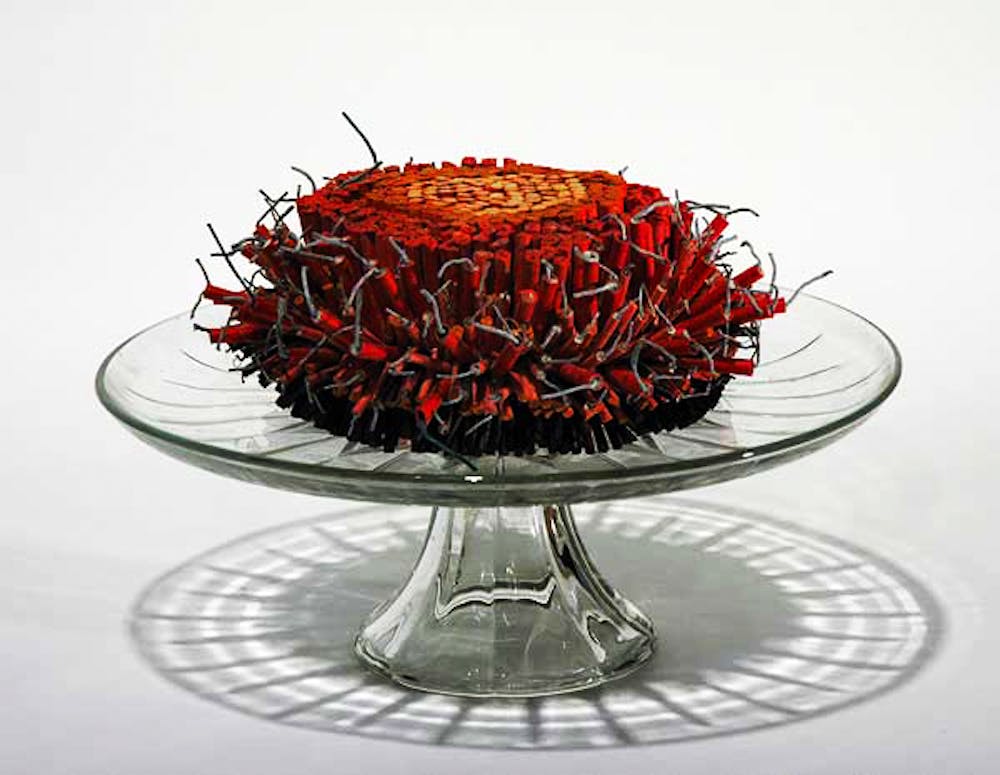ORDNANCE Rebekah Templeton Contemporary Art 173 W. Girard Ave. Wednesday through Saturday, 12–6 p.m. Free rebekahtempleton.com
Camouflaged by graffiti, the front windows of Rebekah Templeton Contemporary Art Gallery are barely noticeable amongst the tattoo parlors and convenience stores lining West Girard Avenue. But if Tim Belknap's socially–charged exhibit, "Ordnance," conveys anything, it's not to judge a situation by its appearance.
Belknap plays with the concept of the term “ordnance,” defined as “military armament and artillery, normally inert and safe unless it's triggered,” by deconstructing suburban household items and transfiguring them into symbols of hazard and distortion. Each sculpture has a CAUTION label already imprinted on the materials the artist chose to utilize, asserting that the idealized American dream comes with a number of cautionary tags as easily disregarded as the one on our dishwashers.
The complacency of suburban dwellers allow these dangers to mount without notice; occupied by dinner parties and television, they are destroyed by ingrained routine and an obsession with the "picture–perfect."
Upon entry, a pile of bones titled Unlovable rests on the gallery's grey plywood floor, an initially indecipherable welcome. Yet the form's debility suddenly confronts the viewer. An arm jutting out from the top of the heap is powered by a series of red, yellow and blue pneumonic tubes, moving slightly before collapsing back to its resting position. Coming to life, the sculpture evokes the mentality of a sick or forgetful grandparent attached to oxygen tubes, struggling to reclaim a role in family life but retracting pathetically when aid and attention fail to present themselves.
Belknap directly exposes this rejection of deformity by juxtaposing the mess of bones with Big Boom–Kake to its right, a nine–layer, multi–colored cake made entirely of firecrackers. Belknap's witty, pastry–shaped interpretation of a Stepford wife is polished and beautiful in appearance but simultaneously on the brink of combustion. And it's hard not to assume that across the room Kakes 1, 2, 3 & 4 made of identical materials represent insincere socialites–in–training. Only a couple layers tall, they will slowly develop the extensive tiers their mother so proudly boasts.
The impossibility of actually taking a bite out of the extravagant cakes speaks to their blatant artificiality, a quality permeating much of the exhibit. From phony captured memories used as wall decor to vibrantly painted lawn mower pieces, a surreal style emphasizes the bright and shiny nature of fake neighborhood interactions without dousing the objects in pessimism.
Perhaps the deepest level of "ordnance" is realized when one steps back from the artistic experience and acknowledges the number of electronics and real, capable explosives concentrated in the gallery's compact 12 x 25 ft. room. This last ironic twist only bolsters Belknap's plea: once in a while we must push ourselves to take an external view of reality, assessing the potential threats of our seemingly harmless surroundings.

